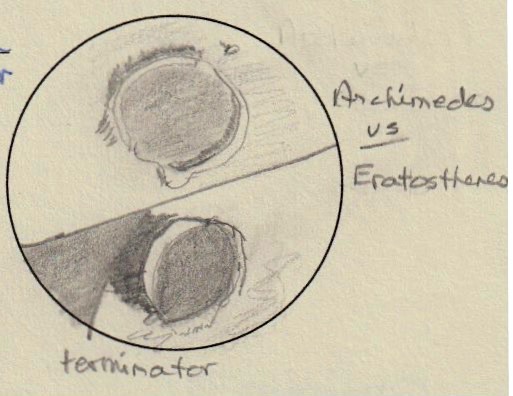IWLOP #096 - Mare Imbrium / Eratosthenes / Copernicus System
This area of the Moon illustrates the overall pages of the major systems. You can trace out the relative ages of each by noting which crater is overlain on the other.
Origin: Impact and Volcanic Size: Various Rukl: 19-22, 9-12, 31 Type: Various
Objects: Mare Imbrium, Archimedes, Eratosthenes
Others Identified: Copernicus
| Location: Home Date: 2019-03-18 Time: 8:43 PM ADT Equipment: 6” Dobsonian, 10 mm eyepiece Magnification: x120 Seeing: Very Good (4) Transparency: Very Good (4) |
 |
NOTE: Archimedes appears shallower than Eratosthenes (based on shadows in their craters). Eratosthenes had taller/longer shadows on its floor and towards the terminator.
| IWLOP: Note these features | My Observation |
| Mare Imbrium lavas fill crater Archimedes; they are post-impact, but pre-Imbrium. | R1: The opening in the NE Archimedes wall allowed for the lava to fill the crater. |
| The crater Eratosthenes is post-Mare Imbrium but pre-Copernican. | R2: In this session, a large shadow covered most of Copernicus' floor. |
| The crater Copernicus is the most recent major impact in this area and overlies older structures. | R3: Copernicus and Montes Carpatus were located. |
| The ejecta blanket surrounding Mare Imbrium is the oldest part of this system and dates back to the Imbrium impact itself. It is especially noticeable in some areas, e.g., in the area of the crater Julius Caesar (Rukl 34). | R4: Mountainous area on shores of Mare Imbrium evidence of ejecta. |